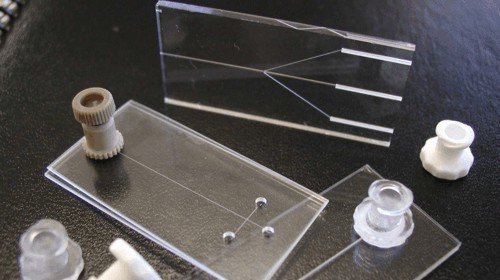Microfluidic Chips
Microfluidic chips, also known as lab-on-a-chip devices, are miniaturized devices that enable the manipulation and analysis of small volumes of fluids on the microliter (10^-6 L) or even nanoliter (10^-9 L) scale. They consist of a network of microchannels, chambers, and valves etched or molded onto a substrate. Microfluidic chips can be used for a variety of applications, including chemical analysis, biological assays, medical diagnostics, and drug discovery. FireflySci offers these in a number of custom configurations and materials.
Here is a detailed breakdown of the components and functions of microfluidic chips:
Substrate Material: The substrate material is typically made of glass, silicon, or polymer materials. The choice of material depends on the specific application and the desired properties of the chip, such as optical transparency, biocompatibility, mechanical strength, and ease of fabrication.
Microchannels: Microchannels are tiny channels etched or molded onto the substrate. These channels range in size from a few micrometers to several hundred micrometers in width and depth. The channels are designed to direct the flow of fluids and can be used to transport and mix reagents, cells, or other biological or chemical substances.
Chambers: Chambers are small compartments or reservoirs within the microfluidic chip where samples can be stored or reactions can occur. Chambers can be used for various applications, such as culturing cells or running polymerase chain reaction (PCR) assays.
Valves: Valves are structures that control the flow of fluids within the microfluidic chip. Valves can be either passive or active. Passive valves rely on the physical properties of the channel to regulate fluid flow, such as changes in channel geometry or the use of hydrophobic or hydrophilic surfaces. Active valves use external pressure or electric fields to open or close the channels.
Pumps: Pumps are devices that generate pressure or suction to move fluids through the microchannels. Pumps can be either active or passive. Passive pumps rely on changes in the channel geometry or the use of capillary forces to move fluids. Active pumps use external forces, such as electric fields or pneumatic pressure, to move fluids.
Sensors: Sensors are devices that can detect and measure various physical or chemical properties of the fluids within the microfluidic chip, such as pH, temperature, pressure, or concentration of specific molecules. Sensors can be integrated into the chip to provide real-time feedback and control of the microfluidic processes.
Detection systems: Detection systems are used to analyze the results of the microfluidic experiments. Detection systems can be optical, electrical, or mechanical, and they can detect a variety of signals, such as fluorescence, absorbance, impedance, or mass.
Fused Silica Straight-Channel Chips
Fused Silica Straight-Channel Chips
Chips with one input and one output port made with fused silica. They have optically clear ceiling and translucent flooring allowing monitoring the microfluidic flow from both sides. Available in multiple channel lengths and depths as well as a customizable optically clear side of top-down or bottom-up; they are also available with the choice of Luer and Upchurch connectors and no connectors at all.
Features of FireflySci Straight-Channel Microfluidic Chips:
Made using high-quality Fused Silica Glass
Thermally Fused Layers
Glass Chip:
2" long x 1" wide
Thickness is either 1.5mm or 1.17mm, depending on Version (Top Down or Bottom Up)
Graduated reticle (1mm spacing) running perpendicular to channel
Configuration: Select from table below (Top-Down [Ports on top], or Bottom-Up [Ports on bottom])
Microfluidic Cell Specifications:
Microfluidic channel with nearly vertical walls and flat bottom
Channel Ceiling: Flat, Transparent (Optical quality)
Channel Floor: Flat, Translucent
Channel Width: 30 micron, 100 micron, 300 micron
Channel Depth: 100 micron, 300 micron
Fluid Connectors: None, Luer, Upchurch







![firefly_logo_FINAL [Black].jpg](https://images.squarespace-cdn.com/content/v1/5411d5c0e4b02e1c8b27565a/1434491508803-XB4OF7YDY46Z72L5U5AP/firefly_logo_FINAL+%5BBlack%5D.jpg)


